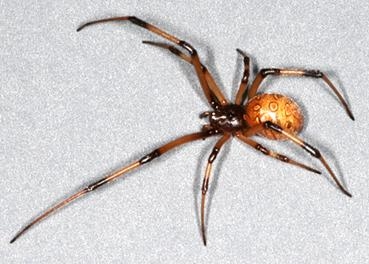
Posts Tagged: Brown widow
Brown Widows Get Foothold in Southern California
[From the February 2013 issue of the UC IPM Green Bulletin newsletter] During the last 10 years, a...
California 'newcomers' brown widow spiders and yellow starthistle in the news

Invasive yellow starthistle aims to take over the world
Sacramento Bee, Sam McManis
Reporter Sam McManis likened yellow starthistle to an overexposed Hollywood star, presenting the bulk of the story as a mock interview with the invasive weed. An editor's note said the article was based on interviews with Joseph M. DiTomaso of the Weed Science Program at UC Davis and Wendy West, coordinator of the yellow starthistle Leading Edge Project for the UC Cooperative Extension. Additional information was provided by the California Invasive Plant Council and the University of California Integrated Pest Management Program.
Spider scientists creep up on elusive prey
Los Angeles Times, Nicole Santa Cruz
UC Riverside scientist Rick Vetter was the primary source for a Los Angeles Times story on brown widow spiders. The exotic spider is "spreading like wildfire" across Southern California, Vetter said. "It's not that big of a deal, but people see the word 'widow' in a name and freak out completely."
Rick Vetter explains brown widow spider identification in the ANR video below:
BrownWidows
Citizen scientists to help track brown widow spiders
Media reports now have residents around the state on the lookout for brown widow spiders, which will help a UC Riverside scientist who is trying to track its rapidly expanding range.
"Wanted dead or alive," announced an article in the Redding Record Searchlight. Reporter Laura Christman tempered the ominous lead with a succinct quote from UC Riverside staff research associate Rick Vetter, "Chill."
"It's nothing to be overly concerned about. I'm more interested from an academic standpoint," Vetter told the reporter.
A native of Africa, brown widows were established in Los Angeles, Orange and San Diego counties as of 2009, and in 2010 made their way to Riverside, San Bernardino, Ventura and Santa Barbara counties. There have been a few finds in areas further north.
Southern California Public Radio KPCC ran an interview with Vetter about brown widows on Sunday. He said the brown widow seems to be displacing black widows - a fact that has benefits and disadvantages.
The brown widow is more likely to play dead than strike out aggressively, however, they tend to congregate in larger numbers and will hang out in places black widows ignore.
"(Brown widows will) be underneath a wrought iron railing or underneath those solar powered lights that you stick in the ground on your walkway. You would never find a black widow in that much of an exposed area," Vetter told the reporter. "It just goes from people having five or six black widows to having 50 to 100 brown widows. And that’s something that you typically would not ignore."
One of Vetter's greatest concerns is a resident's tendency to use more pesticides when confronted with more spiders.
"The spiders are responsible for increasing pesticide load," Vetter said.
For more information and links to Vetter's website, see the UC ANR news release about brown widow spiders. In the 90-second video below, Vetter gives tips for identifying brown widows.
BrownWidows
Brown is the new black
Brown widow spiders are beginning to displace the more dangerous black widows in some parts of California, according to a story in the Riverside Press-Enterprise.
The brown widow spider, a native of South Africa, made its first American home in Florida. It became established in Southern California in the early 2000s and its range continues to expand. As of 2009, the spider was known in Los Angeles, Orange and San Diego counties, but as of 2010, it has shown up in Santa Barbara and Sacramento counties.
"They're very prolific," said Rick Vetter, a UC Riverside urban entomologist who is documenting the species' spread in California. "Where you might find six or seven black widows in a backyard, now you find 100 brown widows."
The mottled tan, brown and gray spiders - like their black cousins - carry the signature hourglass marking on the abdomen, however the brown widow's mark is orange or yellow instead of red. They can also be distinguished by their egg sacs; the brown widow's has spiky protrusions.
Vetter told Press-Enterprise reporter Janet Zimmerman there is concern the brown widow will make its way to California's Central Valley, where they could have an impact on the agricultural industry.
"People don't want the spiders shipped around on their produce," Vetter said.
Although brown widows may congregate in greater numbers and their venom is more potent, the spiders pose less risk than black widows. Brown widows are less likely to bite. Instead they curl up when disturbed and do not defend their egg sacs. When they do bite, they release less venom than black widows.
"Most of the bites recorded so far have been very mild," such as pain and redness at the bite site, Vetter was quoted in the story.
Vetter asks that California residents outside of LA, Orange and Ventura counties send him samples of brown widows they find so he can track their spread. For more information, see Vetter's webpage.

Brown widow
